Medical Textiles Market Size 2025-2029
The medical textiles market size is valued to increase by USD 7.65 billion, at a CAGR of 6.6% from 2024 to 2029. Growing demand for nonwoven medical textiles will drive the medical textiles market.
Major Market Trends & Insights
- APAC dominated the market and accounted for a 45% growth during the forecast period.
- By Product - Woven segment was valued at USD 7.07 billion in 2023
- By Application - Surgical segment accounted for the largest market revenue share in 2023
Market Size & Forecast
- Market Opportunities: USD 77.79 million
- Market Future Opportunities: USD 7650.20 million
- CAGR from 2024 to 2029 : 6.6%
Market Summary
- The market experiences continuous expansion due to the increasing demand for advanced fabric solutions in healthcare applications. One significant trend driving this growth is the adoption of nonwoven medical textiles, which offer superior absorbency, breathability, and strength compared to traditional woven fabrics. These properties make nonwoven medical textiles ideal for use in disposable medical garments, surgical gowns, and wound dressings. Another emerging trend is the integration of nanofibers into medical textiles. Nanofibers' unique properties, such as high surface area-to-volume ratio and small pore size, enable superior moisture management, bacterial filtration, and tissue regeneration. Consequently, nanofiber-based medical textiles find extensive applications in areas like burn dressings, tissue engineering, and air filtration systems.
- However, the market faces challenges due to the volatility of crude oil prices, which significantly impact the production costs of synthetic textiles. The industry's response involves exploring alternative, eco-friendly raw materials and improving production efficiency to mitigate these price fluctuations. With the ongoing advancements in material science and technology, medical textiles continue to evolve, offering innovative solutions to meet the growing demands of the healthcare sector. The market's future direction lies in the development of smart textiles, which integrate sensors, actuators, and other functionalities to enhance patient care and monitoring. The market size was valued at USD 33.2 billion in 2019.
- This data point underscores the market's robust expansion and the significant opportunities it presents for businesses in this sector.
What will be the Size of the Medical Textiles Market during the forecast period?
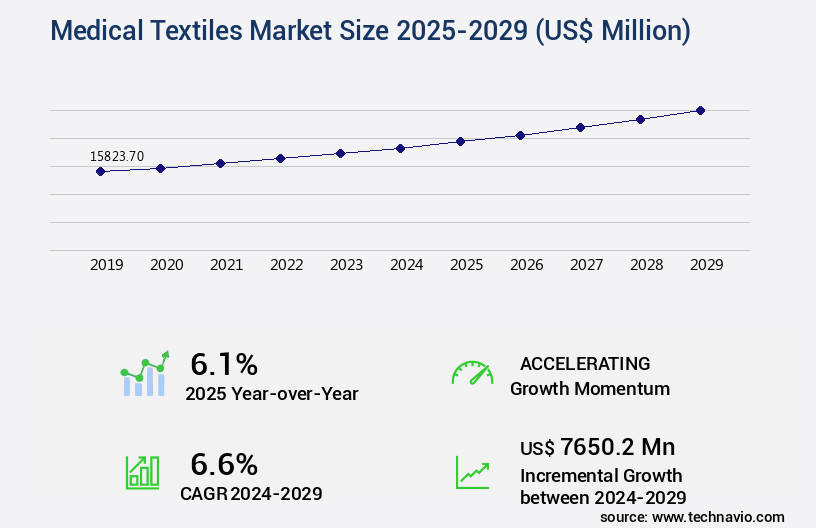
Get Key Insights on Market Forecast (PDF) Request Free Sample
How is the Medical Textiles Market Segmented?
The medical textiles industry research report provides comprehensive data (region-wise segment analysis), with forecasts and estimates in "USD million" for the period 2025-2029, as well as historical data from 2019-2023 for the following segments.
- Product
- Application
- Surgical
- Healthcare and hygiene products
- Extracorporeal
- Type
- Non-implantable goods
- Implantable goods
- Geography
- North America
- Europe
- APAC
- Australia
- China
- India
- Japan
- South Korea
- Rest of World (ROW)
By Product Insights
The woven segment is estimated to witness significant growth during the forecast period.
Woven medical textiles, a crucial segment of the dynamic and evolving biothe market, are manufactured using interlaced yarns at right angles, resulting in a durable and stable fabric. These textiles exhibit desirable properties such as dimensional stability, flexibility, and low elongation, making them suitable for various medical applications. For instance, surgical gowns demand high-performance fabrics that offer controlled porosity, ensuring infection control and skin contact comfort, while maintaining burst and suture retention strengths. Woven textiles are also used in the production of surgical drapes, which require both high tensile strength and abrasion resistance. Furthermore, woven medical textiles play a pivotal role in tissue engineering scaffolds, where porosity measurement and mechanical properties are essential.
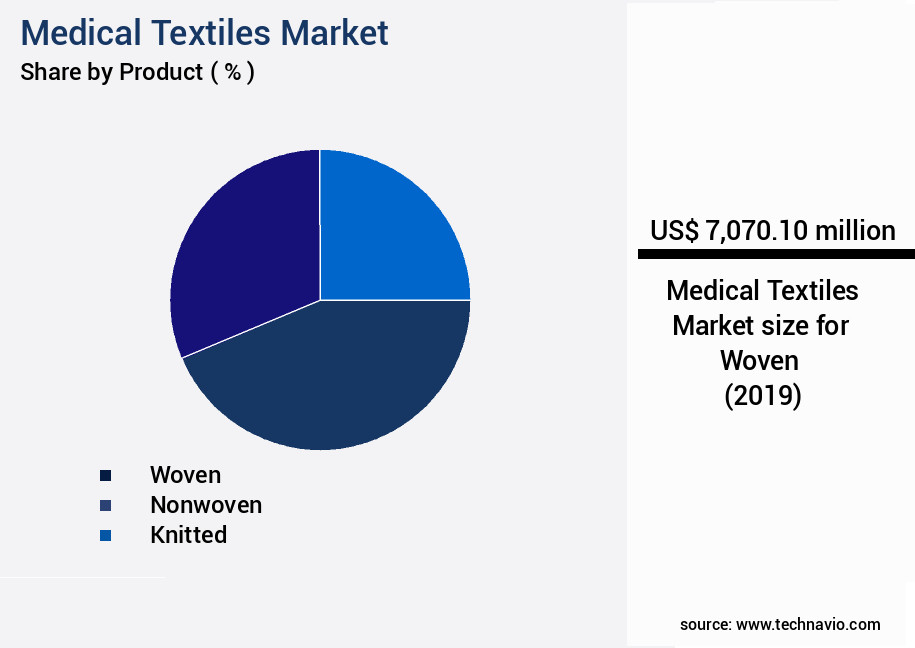
Request Free Sample
The Woven segment was valued at USD 7.07 billion in 2019 and showed a gradual increase during the forecast period.
The global market for medical textiles is projected to reach a value of USD 34.5 billion by 2025. This growth is attributed to the increasing demand for advanced medical textiles, such as hydrophilic and hydrophobic fibers, electrospun nanofibers, and smart textiles, in applications ranging from orthopedic devices and compression garments to wound dressings and drug delivery systems.
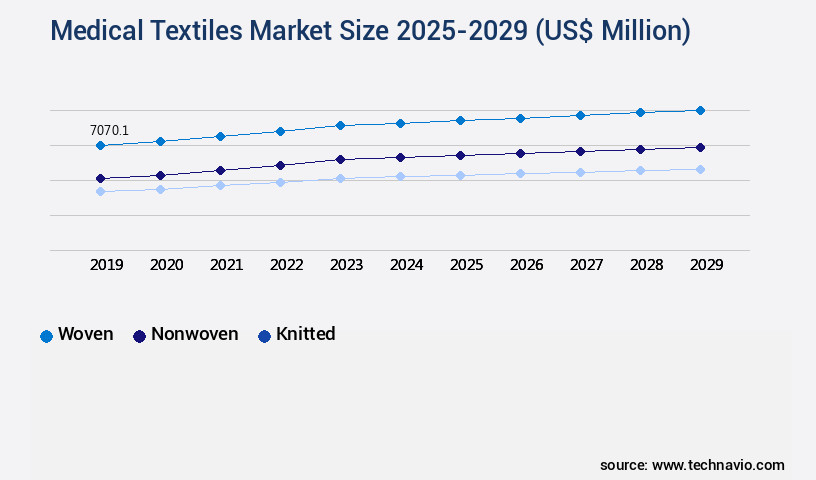
Request Free Sample
Regional Analysis
APAC is estimated to contribute 45% to the growth of the global market during the forecast period. Technavio's analysts have elaborately explained the regional trends and drivers that shape the market during the forecast period.
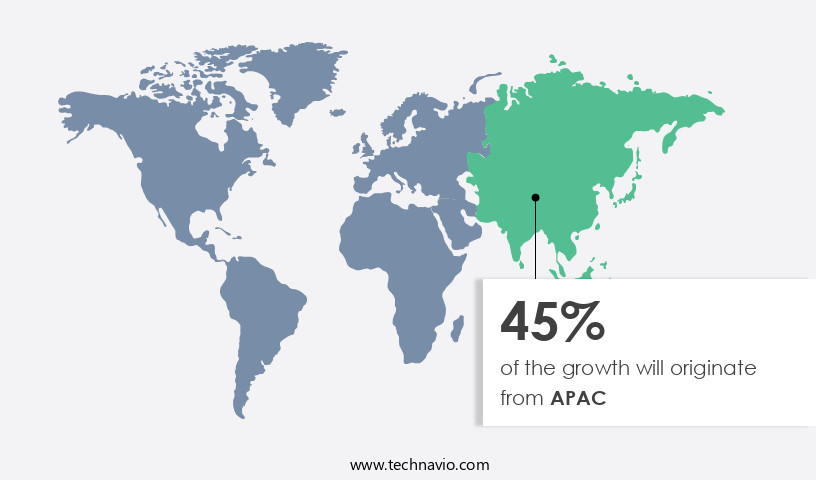
See How Medical Textiles Market Demand is Rising in APAC Request Free Sample
The market in Asia Pacific (APAC) is experiencing significant growth, driven by the expansion of various medical manufacturing industries in the region. With increasing industrialization and urbanization, the demand for medical textiles is on the rise. Countries such as China, India, Japan, and South Korea are leading contributors to this market's growth in APAC. The production of medical textiles is indigenous in China and South Korea, and these countries are also witnessing rapid penetration of medical textiles in countries like India, Malaysia, China, South Korea, and Japan.
The market in APAC is projected to grow steadily during the forecast period. The growth is fueled by the increasing demand for medical textiles due to their essential role in healthcare applications, such as surgical gowns, wound care dressings, and medical filters. The market's expansion is further supported by advancements in technology and innovation, leading to the development of high-performance medical textiles.
Market Dynamics
Our researchers analyzed the data with 2024 as the base year, along with the key drivers, trends, and challenges. A holistic analysis of drivers will help companies refine their marketing strategies to gain a competitive advantage.
The market encompasses a diverse range of textile products engineered for various healthcare applications. One significant segment of this market includes advanced wound dressings based on polyurethane, which offer superior moisture management and enhanced healing properties. In the realm of wound care, electrospinning parameters are utilized to create nanofiber mats for improved adherence and faster healing. Another burgeoning area is hydrophilic modification of cotton fabrics, which enhances their moisture absorption capabilities, making them suitable for use in medical textiles. Antimicrobial textiles infused with silver nanoparticles are gaining popularity due to their effective resistance to bacterial growth. Shape memory alloys find extensive applications in surgical instruments and implants, while biocompatible polymer blends are essential for medical implants' success. Advanced textile manufacturing processes, such as nonwoven fabrics and high-performance fiber spinning methods, are crucial for optimizing filtration efficiency and surgical gown barrier protection performance. Testing methods for biocompatibility are essential in ensuring medical textiles' safety and efficacy. Compression garments are designed with patient comfort in mind, while smart textile sensors enable health monitoring through real-time data collection. The drug eluting stent manufacturing process benefits from textiles' ability to control drug release rates, while tissue engineering scaffolds require careful design parameters for optimal biodegradation rates. Surface treatment technologies, including antimicrobial effects and coating applications, play a vital role in enhancing medical textiles' functionality and durability. Overall, the market continues to evolve, driven by technological advancements and the growing demand for innovative, high-performance textile solutions.
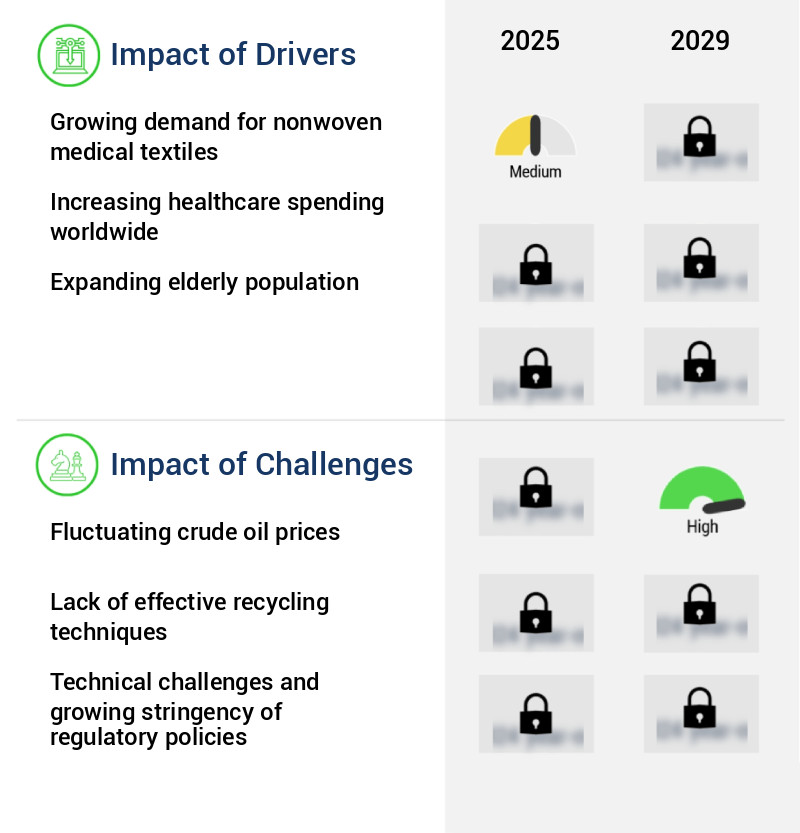
What are the key market drivers leading to the rise in the adoption of Medical Textiles Industry?
- The increasing demand for nonwoven medical textiles, known for their versatility and effectiveness in various medical applications, serves as the primary growth driver for this market.
- Nonwoven medical textiles have gained significant traction in various sectors due to their versatile applications. These textiles are integral to an array of products, encompassing absorbent pads, incontinence items, patient and staff apparel, baby diapers, bed linen, burn dressings, gowns, disposable underwear, drug delivery devices, face masks, filter media, nasal strips, pillows, shoe covers, sponges, sutures, tissue scaffolds, towels, and wraps. The raw materials employed in the production of nonwoven medical textiles consist of natural and synthetic fibers. Among natural fibers, wood pulp, cotton, and rayon are commonly used.
- Wood pulp, with its absorbency, bulk, and cost-effectiveness, is a preferred choice. Meanwhile, cotton and rayon are gentle enough for use on wounds due to their inherent softness. The nonwoven market's scope is extensive, catering to diverse industries and applications.
What are the market trends shaping the Medical Textiles Industry?
- In the medical sector, the demand for nanofibers is experiencing significant growth, representing an emerging market trend.
- Nanofibers, a class of one-dimensional nanomaterials, have gained significant attention in the medical and healthcare sectors due to their unique properties and functionalities. Manufactured using biocompatible or biodegradable materials, nanofibers exhibit a high surface area and porosity, which enhances the adhesion of cells, proteins, and drug molecules. This superiority over micro and macro counterparts made of the same materials is driving their adoption in various medical applications. Nanofibers play a pivotal role in tissue engineering and wound healing. In tissue engineering, they serve as scaffolds for cell growth and tissue regeneration. In wound healing, nanofibers promote faster healing by providing a protective barrier and facilitating the growth of new tissue.
- Moreover, nanofibers are increasingly being used in drug delivery systems. The nanofiber membrane from biopolymers acts as a bioactive material or drug carrier, enabling controlled drug release and enhancing therapeutic efficacy. The versatility and potential of nanofibers in the medical industry are evident from their growing usage across various sectors. Nanofibers are poised to play a crucial role in this growth, with their share projected to increase significantly.
What challenges does the Medical Textiles Industry face during its growth?
- The volatility of crude oil prices poses a significant challenge to the growth of the industry.
- Synthetic fibers, primarily manufactured from petroleum-derived raw materials like polyester, polyamide, polyvinyl alcohol, and polyurethane urea (PUUR), are the backbone of the medical textiles industry. These fibers, which are predominantly polymers, are sourced from crude oil. The volatility of crude oil prices significantly influences the cost of these raw materials, subsequently impacting the pricing dynamics of synthetic fibers in the market. The unpredictability of crude oil prices can lead to considerable fluctuations in the manufacturing costs of synthetic fibers, ultimately influencing the pricing structure of medical textiles.
- The interconnectedness of these factors underscores the market's evolving nature and its applications across various sectors.
Exclusive Technavio Analysis on Customer Landscape
The medical textiles market forecasting report includes the adoption lifecycle of the market, covering from the innovator's stage to the laggard's stage. It focuses on adoption rates in different regions based on penetration. Furthermore, the medical textiles market report also includes key purchase criteria and drivers of price sensitivity to help companies evaluate and develop their market growth analysis strategies.
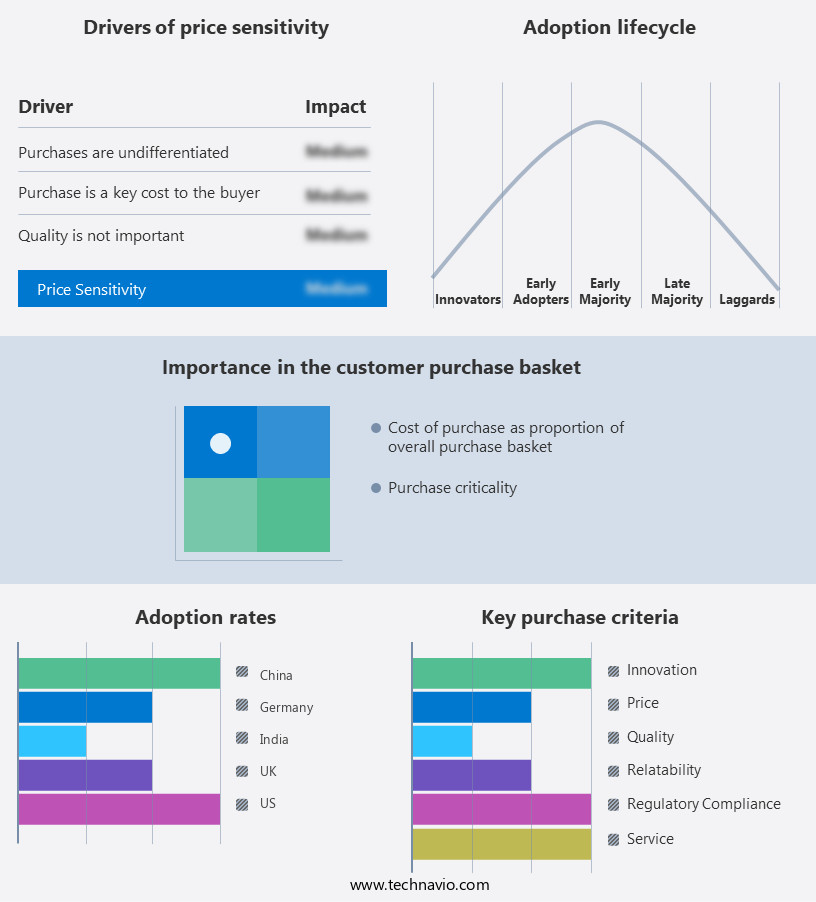
Customer Landscape of Medical Textiles Industry
Competitive Landscape
Companies are implementing various strategies, such as strategic alliances, medical textiles market forecast, partnerships, mergers and acquisitions, geographical expansion, and product/service launches, to enhance their presence in the industry.
Ahlstrom - This company specializes in the production and distribution of advanced medical textiles, including gowns, apparel, drapes, facemasks, and coveralls, under the brands PureArmor, Virosel, and VaporCool.
The industry research and growth report includes detailed analyses of the competitive landscape of the market and information about key companies, including:
- Ahlstrom
- Asahi Kasei Corp.
- ATEX Technologies Inc.
- Bally Ribbon Mills
- Cardinal Health Inc.
- Confluent Medical Technologies
- First Quality Enterprises Inc.
- Freudenberg and Co. KG
- Gebruder Aurich GmbH
- Getinge AB
- Kimberly Clark Corp.
- KOB GmbH
- PFNonwovens Holding s.r.o.
- Schoeller Textil AG
- Schouw and Co.
- TWE GmbH and Co. KG
- Tytex AS
- W.Ball and Son Ltd.
Qualitative and quantitative analysis of companies has been conducted to help clients understand the wider business environment as well as the strengths and weaknesses of key industry players. Data is qualitatively analyzed to categorize companies as pure play, category-focused, industry-focused, and diversified; it is quantitatively analyzed to categorize companies as dominant, leading, strong, tentative, and weak.
Recent Development and News in Medical Textiles Market
- In January 2024, Medtronic plc, a global healthcare solutions company, announced the launch of its new line of advanced wound care textiles, Infusaid+, featuring an integrated antimicrobial technology (Medtronic press release). This innovation aims to reduce infection rates and enhance patient recovery.
- In March 2024, 3M and Tessy Plastics Corporation, a leading medical textiles manufacturer, entered into a strategic partnership to expand their offerings in the market. The collaboration combines 3M's advanced medical textiles technology with Tessy Plastics' manufacturing expertise (3M press release).
- In April 2025, Avery Dennison Corporation, a global materials science and specialty manufacturing company, completed the acquisition of Mactac, a leading provider of pressure-sensitive adhesive tapes and textiles for the medical industry. The acquisition strengthens Avery Dennison's position in the market and expands its product portfolio (Avery Dennison press release).
- In May 2025, the European Commission approved the use of a new type of medical textile, Biostable's BioFlex, for use in hernia repair procedures. This approval marks a significant milestone for the company, as its biocompatible and self-reinforcing textile offers advantages over traditional mesh materials (European Commission press release).
Dive into Technavio's robust research methodology, blending expert interviews, extensive data synthesis, and validated models for unparalleled Medical Textiles Market insights. See full methodology.
|
Market Scope
|
|
Report Coverage
|
Details
|
|
Page number
|
221
|
|
Base year
|
2024
|
|
Historic period
|
2019-2023 |
|
Forecast period
|
2025-2029
|
|
Growth momentum & CAGR
|
Accelerate at a CAGR of 6.6%
|
|
Market growth 2025-2029
|
USD 7650.2 million
|
|
Market structure
|
Fragmented
|
|
YoY growth 2024-2025(%)
|
6.1
|
|
Key countries
|
US, China, Germany, UK, India, Canada, Japan, South Korea, France, and Australia
|
|
Competitive landscape
|
Leading Companies, Market Positioning of Companies, Competitive Strategies, and Industry Risks
|
Request Free Sample
Research Analyst Overview
- The dynamic market continues to evolve, driven by advancements in materials science and the expanding application landscape. Polyester and polypropylene fabrics, with their high tensile strength and durability, dominate the market, finding extensive use in orthopedic devices and surgical gowns. However, the emergence of hydrophilic and hydrophobic fibers, such as those used in wound dressings and fluid absorption materials, is gaining traction. Infection control remains a primary focus, with sterilization methods and biocompatibility testing playing crucial roles. For instance, the use of electrospun nanofibers in antimicrobial textiles has shown a significant reduction in bacterial growth by up to 99.9%.
- The industry is projected to grow at a robust rate, with expectations of a 7% annual expansion. Beyond traditional applications, medical textiles are increasingly integrated into wearable sensors, compression garments, and tissue engineering scaffolds. Innovations in fiber spinning technologies, such as those used in producing shape memory polymers and knitted structures, are revolutionizing the field of medical implants. Porosity measurement and mechanical properties are essential considerations in the development of tissue engineering scares and absorbable sutures. The ongoing research and development in biomedical textiles, including drug delivery systems and skin contact materials, underscore the continuous unfolding of market activities and evolving patterns.
- The integration of smart textiles into medical applications, such as sensors and compression garments, is a promising trend, offering enhanced functionality and improved patient outcomes.
What are the Key Data Covered in this Medical Textiles Market Research and Growth Report?
-
What is the expected growth of the Medical Textiles Market between 2025 and 2029?
-
What segmentation does the market report cover?
-
The report is segmented by Product (Woven, Nonwoven, and Knitted), Application (Surgical, Healthcare and hygiene products, and Extracorporeal), Type (Non-implantable goods and Implantable goods), and Geography (APAC, Europe, North America, South America, and Middle East and Africa)
-
Which regions are analyzed in the report?
-
APAC, Europe, North America, South America, and Middle East and Africa
-
What are the key growth drivers and market challenges?
-
Who are the major players in the Medical Textiles Market?
-
Ahlstrom, Asahi Kasei Corp., ATEX Technologies Inc., Bally Ribbon Mills, Cardinal Health Inc., Confluent Medical Technologies, First Quality Enterprises Inc., Freudenberg and Co. KG, Gebruder Aurich GmbH, Getinge AB, Kimberly Clark Corp., KOB GmbH, PFNonwovens Holding s.r.o., Schoeller Textil AG, Schouw and Co., TWE GmbH and Co. KG, Tytex AS, and W.Ball and Son Ltd.
Market Research Insights
- The market is a dynamic and ever-evolving industry, characterized by continuous innovation and advancements. This sector encompasses a wide range of textile applications in healthcare, from surgical gowns and drapes to wound care dressings and diagnostic textiles. Two significant data points illustrate the market's growth and development. First, the market is projected to expand at a steady rate, with industry analysts estimating a growth of approximately 6% annually. Second, an example of market dynamics comes from the increased adoption of advanced surface treatments in medical textiles.
- For instance, the use of antimicrobial coatings in surgical gowns has resulted in a sales increase of over 10% in recent years, demonstrating the demand for enhanced infection control and patient safety.
We can help! Our analysts can customize this medical textiles market research report to meet your requirements.
Get in touch
1 Executive Summary
- 1.1 Market overview
- Executive Summary - Chart on Market Overview
- Executive Summary - Data Table on Market Overview
- Executive Summary - Chart on Global Market Characteristics
- Executive Summary - Chart on Market by Geography
- Executive Summary - Chart on Market Segmentation by Product
- Executive Summary - Chart on Market Segmentation by Application
- Executive Summary - Chart on Market Segmentation by Type
- Executive Summary - Chart on Incremental Growth
- Executive Summary - Data Table on Incremental Growth
- Executive Summary - Chart on Company Market Positioning
2 Technavio Analysis
- 2.1 Analysis of price sensitivity, lifecycle, customer purchase basket, adoption rates, and purchase criteria
- Analysis of price sensitivity, lifecycle, customer purchase basket, adoption rates, and purchase criteria
- 2.2 Criticality of inputs and Factors of differentiation
- Overview on criticality of inputs and factors of differentiation
- 2.3 Factors of disruption
- Overview on factors of disruption
- 2.4 Impact of drivers and challenges
- Impact of drivers and challenges in 2024 and 2029
3 Market Landscape
- 3.1 Market ecosystem
- Parent Market
- Data Table on - Parent Market
- 3.2 Market characteristics
- Market characteristics analysis
4 Market Sizing
- 4.1 Market definition
- Offerings of companies included in the market definition
- 4.2 Market segment analysis
- 4.4 Market outlook: Forecast for 2024-2029
- Chart on Global - Market size and forecast 2024-2029 ($ million)
- Data Table on Global - Market size and forecast 2024-2029 ($ million)
- Chart on Global Market: Year-over-year growth 2024-2029 (%)
- Data Table on Global Market: Year-over-year growth 2024-2029 (%)
5 Historic Market Size
- 5.1 Global Medical Textiles Market 2019 - 2023
- Historic Market Size - Data Table on Global Medical Textiles Market 2019 - 2023 ($ million)
- 5.2 Product segment analysis 2019 - 2023
- Historic Market Size - Product Segment 2019 - 2023 ($ million)
- 5.3 Application segment analysis 2019 - 2023
- Historic Market Size - Application Segment 2019 - 2023 ($ million)
- 5.4 Type segment analysis 2019 - 2023
- Historic Market Size - Type Segment 2019 - 2023 ($ million)
- 5.5 Geography segment analysis 2019 - 2023
- Historic Market Size - Geography Segment 2019 - 2023 ($ million)
- 5.6 Country segment analysis 2019 - 2023
- Historic Market Size - Country Segment 2019 - 2023 ($ million)
6 Qualitative Analysis
- 6.1 Impact of AI on Global Medical textiles Market
7 Five Forces Analysis
- 7.1 Five forces summary
- Five forces analysis - Comparison between 2024 and 2029
- 7.2 Bargaining power of buyers
- Bargaining power of buyers - Impact of key factors 2024 and 2029
- 7.3 Bargaining power of suppliers
- Bargaining power of suppliers - Impact of key factors in 2024 and 2029
- 7.4 Threat of new entrants
- Threat of new entrants - Impact of key factors in 2024 and 2029
- 7.5 Threat of substitutes
- Threat of substitutes - Impact of key factors in 2024 and 2029
- 7.6 Threat of rivalry
- Threat of rivalry - Impact of key factors in 2024 and 2029
- 7.7 Market condition
- Chart on Market condition - Five forces 2024 and 2029
8 Market Segmentation by Product
- 8.1 Market segments
- Chart on Product - Market share 2024-2029 (%)
- Data Table on Product - Market share 2024-2029 (%)
- 8.2 Comparison by Product
- Chart on Comparison by Product
- Data Table on Comparison by Product
- 8.3 Woven - Market size and forecast 2024-2029
- Chart on Woven - Market size and forecast 2024-2029 ($ million)
- Data Table on Woven - Market size and forecast 2024-2029 ($ million)
- Chart on Woven - Year-over-year growth 2024-2029 (%)
- Data Table on Woven - Year-over-year growth 2024-2029 (%)
- 8.4 Nonwoven - Market size and forecast 2024-2029
- Chart on Nonwoven - Market size and forecast 2024-2029 ($ million)
- Data Table on Nonwoven - Market size and forecast 2024-2029 ($ million)
- Chart on Nonwoven - Year-over-year growth 2024-2029 (%)
- Data Table on Nonwoven - Year-over-year growth 2024-2029 (%)
- 8.5 Knitted - Market size and forecast 2024-2029
- Chart on Knitted - Market size and forecast 2024-2029 ($ million)
- Data Table on Knitted - Market size and forecast 2024-2029 ($ million)
- Chart on Knitted - Year-over-year growth 2024-2029 (%)
- Data Table on Knitted - Year-over-year growth 2024-2029 (%)
- 8.6 Market opportunity by Product
- Market opportunity by Product ($ million)
- Data Table on Market opportunity by Product ($ million)
9 Market Segmentation by Application
- 9.1 Market segments
- Chart on Application - Market share 2024-2029 (%)
- Data Table on Application - Market share 2024-2029 (%)
- 9.2 Comparison by Application
- Chart on Comparison by Application
- Data Table on Comparison by Application
- 9.3 Surgical - Market size and forecast 2024-2029
- Chart on Surgical - Market size and forecast 2024-2029 ($ million)
- Data Table on Surgical - Market size and forecast 2024-2029 ($ million)
- Chart on Surgical - Year-over-year growth 2024-2029 (%)
- Data Table on Surgical - Year-over-year growth 2024-2029 (%)
- 9.4 Healthcare and hygiene products - Market size and forecast 2024-2029
- Chart on Healthcare and hygiene products - Market size and forecast 2024-2029 ($ million)
- Data Table on Healthcare and hygiene products - Market size and forecast 2024-2029 ($ million)
- Chart on Healthcare and hygiene products - Year-over-year growth 2024-2029 (%)
- Data Table on Healthcare and hygiene products - Year-over-year growth 2024-2029 (%)
- 9.5 Extracorporeal - Market size and forecast 2024-2029
- Chart on Extracorporeal - Market size and forecast 2024-2029 ($ million)
- Data Table on Extracorporeal - Market size and forecast 2024-2029 ($ million)
- Chart on Extracorporeal - Year-over-year growth 2024-2029 (%)
- Data Table on Extracorporeal - Year-over-year growth 2024-2029 (%)
- 9.6 Market opportunity by Application
- Market opportunity by Application ($ million)
- Data Table on Market opportunity by Application ($ million)
10 Market Segmentation by Type
- 10.1 Market segments
- Chart on Type - Market share 2024-2029 (%)
- Data Table on Type - Market share 2024-2029 (%)
- 10.2 Comparison by Type
- Chart on Comparison by Type
- Data Table on Comparison by Type
- 10.3 Non-implantable goods - Market size and forecast 2024-2029
- Chart on Non-implantable goods - Market size and forecast 2024-2029 ($ million)
- Data Table on Non-implantable goods - Market size and forecast 2024-2029 ($ million)
- Chart on Non-implantable goods - Year-over-year growth 2024-2029 (%)
- Data Table on Non-implantable goods - Year-over-year growth 2024-2029 (%)
- 10.4 Implantable goods - Market size and forecast 2024-2029
- Chart on Implantable goods - Market size and forecast 2024-2029 ($ million)
- Data Table on Implantable goods - Market size and forecast 2024-2029 ($ million)
- Chart on Implantable goods - Year-over-year growth 2024-2029 (%)
- Data Table on Implantable goods - Year-over-year growth 2024-2029 (%)
- 10.5 Market opportunity by Type
- Market opportunity by Type ($ million)
- Data Table on Market opportunity by Type ($ million)
11 Customer Landscape
- 11.1 Customer landscape overview
- Analysis of price sensitivity, lifecycle, customer purchase basket, adoption rates, and purchase criteria
12 Geographic Landscape
- 12.1 Geographic segmentation
- Chart on Market share by geography 2024-2029 (%)
- Data Table on Market share by geography 2024-2029 (%)
- 12.2 Geographic comparison
- Chart on Geographic comparison
- Data Table on Geographic comparison
- 12.3 APAC - Market size and forecast 2024-2029
- Chart on APAC - Market size and forecast 2024-2029 ($ million)
- Data Table on APAC - Market size and forecast 2024-2029 ($ million)
- Chart on APAC - Year-over-year growth 2024-2029 (%)
- Data Table on APAC - Year-over-year growth 2024-2029 (%)
- 12.4 Europe - Market size and forecast 2024-2029
- Chart on Europe - Market size and forecast 2024-2029 ($ million)
- Data Table on Europe - Market size and forecast 2024-2029 ($ million)
- Chart on Europe - Year-over-year growth 2024-2029 (%)
- Data Table on Europe - Year-over-year growth 2024-2029 (%)
- 12.5 North America - Market size and forecast 2024-2029
- Chart on North America - Market size and forecast 2024-2029 ($ million)
- Data Table on North America - Market size and forecast 2024-2029 ($ million)
- Chart on North America - Year-over-year growth 2024-2029 (%)
- Data Table on North America - Year-over-year growth 2024-2029 (%)
- 12.6 South America - Market size and forecast 2024-2029
- Chart on South America - Market size and forecast 2024-2029 ($ million)
- Data Table on South America - Market size and forecast 2024-2029 ($ million)
- Chart on South America - Year-over-year growth 2024-2029 (%)
- Data Table on South America - Year-over-year growth 2024-2029 (%)
- 12.7 Middle East and Africa - Market size and forecast 2024-2029
- Chart on Middle East and Africa - Market size and forecast 2024-2029 ($ million)
- Data Table on Middle East and Africa - Market size and forecast 2024-2029 ($ million)
- Chart on Middle East and Africa - Year-over-year growth 2024-2029 (%)
- Data Table on Middle East and Africa - Year-over-year growth 2024-2029 (%)
- 12.8 US - Market size and forecast 2024-2029
- Chart on US - Market size and forecast 2024-2029 ($ million)
- Data Table on US - Market size and forecast 2024-2029 ($ million)
- Chart on US - Year-over-year growth 2024-2029 (%)
- Data Table on US - Year-over-year growth 2024-2029 (%)
- 12.9 China - Market size and forecast 2024-2029
- Chart on China - Market size and forecast 2024-2029 ($ million)
- Data Table on China - Market size and forecast 2024-2029 ($ million)
- Chart on China - Year-over-year growth 2024-2029 (%)
- Data Table on China - Year-over-year growth 2024-2029 (%)
- 12.10 Germany - Market size and forecast 2024-2029
- Chart on Germany - Market size and forecast 2024-2029 ($ million)
- Data Table on Germany - Market size and forecast 2024-2029 ($ million)
- Chart on Germany - Year-over-year growth 2024-2029 (%)
- Data Table on Germany - Year-over-year growth 2024-2029 (%)
- 12.11 India - Market size and forecast 2024-2029
- Chart on India - Market size and forecast 2024-2029 ($ million)
- Data Table on India - Market size and forecast 2024-2029 ($ million)
- Chart on India - Year-over-year growth 2024-2029 (%)
- Data Table on India - Year-over-year growth 2024-2029 (%)
- 12.12 UK - Market size and forecast 2024-2029
- Chart on UK - Market size and forecast 2024-2029 ($ million)
- Data Table on UK - Market size and forecast 2024-2029 ($ million)
- Chart on UK - Year-over-year growth 2024-2029 (%)
- Data Table on UK - Year-over-year growth 2024-2029 (%)
- 12.13 Japan - Market size and forecast 2024-2029
- Chart on Japan - Market size and forecast 2024-2029 ($ million)
- Data Table on Japan - Market size and forecast 2024-2029 ($ million)
- Chart on Japan - Year-over-year growth 2024-2029 (%)
- Data Table on Japan - Year-over-year growth 2024-2029 (%)
- 12.14 Canada - Market size and forecast 2024-2029
- Chart on Canada - Market size and forecast 2024-2029 ($ million)
- Data Table on Canada - Market size and forecast 2024-2029 ($ million)
- Chart on Canada - Year-over-year growth 2024-2029 (%)
- Data Table on Canada - Year-over-year growth 2024-2029 (%)
- 12.15 South Korea - Market size and forecast 2024-2029
- Chart on South Korea - Market size and forecast 2024-2029 ($ million)
- Data Table on South Korea - Market size and forecast 2024-2029 ($ million)
- Chart on South Korea - Year-over-year growth 2024-2029 (%)
- Data Table on South Korea - Year-over-year growth 2024-2029 (%)
- 12.16 France - Market size and forecast 2024-2029
- Chart on France - Market size and forecast 2024-2029 ($ million)
- Data Table on France - Market size and forecast 2024-2029 ($ million)
- Chart on France - Year-over-year growth 2024-2029 (%)
- Data Table on France - Year-over-year growth 2024-2029 (%)
- 12.17 Australia - Market size and forecast 2024-2029
- Chart on Australia - Market size and forecast 2024-2029 ($ million)
- Data Table on Australia - Market size and forecast 2024-2029 ($ million)
- Chart on Australia - Year-over-year growth 2024-2029 (%)
- Data Table on Australia - Year-over-year growth 2024-2029 (%)
- 12.18 Market opportunity by geography
- Market opportunity by geography ($ million)
- Data Tables on Market opportunity by geography ($ million)
13 Drivers, Challenges, and Opportunity/Restraints
- 13.3 Impact of drivers and challenges
- Impact of drivers and challenges in 2024 and 2029
- 13.4 Market opportunities/restraints
14 Competitive Landscape
- 14.2 Competitive Landscape
- Overview on criticality of inputs and factors of differentiation
- 14.3 Landscape disruption
- Overview on factors of disruption
- 14.4 Industry risks
- Impact of key risks on business
15 Competitive Analysis
- 15.2 Company ranking index
- 15.3 Market positioning of companies
- Matrix on companies position and classification
- 15.4 Ahlstrom
- Ahlstrom - Overview
- Ahlstrom - Product / Service
- Ahlstrom - Key news
- Ahlstrom - Key offerings
- SWOT
- 15.5 Asahi Kasei Corp.
- Asahi Kasei Corp. - Overview
- Asahi Kasei Corp. - Business segments
- Asahi Kasei Corp. - Key news
- Asahi Kasei Corp. - Key offerings
- Asahi Kasei Corp. - Segment focus
- SWOT
- 15.6 ATEX Technologies Inc.
- ATEX Technologies Inc. - Overview
- ATEX Technologies Inc. - Product / Service
- ATEX Technologies Inc. - Key offerings
- SWOT
- 15.7 Bally Ribbon Mills
- Bally Ribbon Mills - Overview
- Bally Ribbon Mills - Product / Service
- Bally Ribbon Mills - Key offerings
- SWOT
- 15.8 Cardinal Health Inc.
- Cardinal Health Inc. - Overview
- Cardinal Health Inc. - Business segments
- Cardinal Health Inc. - Key news
- Cardinal Health Inc. - Key offerings
- Cardinal Health Inc. - Segment focus
- SWOT
- 15.9 Confluent Medical Technologies
- Confluent Medical Technologies - Overview
- Confluent Medical Technologies - Product / Service
- Confluent Medical Technologies - Key news
- Confluent Medical Technologies - Key offerings
- SWOT
- 15.10 Freudenberg and Co. KG
- Freudenberg and Co. KG - Overview
- Freudenberg and Co. KG - Product / Service
- Freudenberg and Co. KG - Key news
- Freudenberg and Co. KG - Key offerings
- SWOT
- 15.11 Getinge AB
- Getinge AB - Overview
- Getinge AB - Business segments
- Getinge AB - Key news
- Getinge AB - Key offerings
- Getinge AB - Segment focus
- SWOT
- 15.12 Kimberly Clark Corp.
- Kimberly Clark Corp. - Overview
- Kimberly Clark Corp. - Business segments
- Kimberly Clark Corp. - Key news
- Kimberly Clark Corp. - Key offerings
- Kimberly Clark Corp. - Segment focus
- SWOT
- 15.13 KOB GmbH
- KOB GmbH - Overview
- KOB GmbH - Product / Service
- KOB GmbH - Key offerings
- SWOT
- 15.14 Schoeller Textil AG
- Schoeller Textil AG - Overview
- Schoeller Textil AG - Product / Service
- Schoeller Textil AG - Key offerings
- SWOT
- 15.15 Schouw and Co.
- Schouw and Co. - Overview
- Schouw and Co. - Business segments
- Schouw and Co. - Key offerings
- Schouw and Co. - Segment focus
- SWOT
- 15.16 TWE GmbH and Co. KG
- TWE GmbH and Co. KG - Overview
- TWE GmbH and Co. KG - Product / Service
- TWE GmbH and Co. KG - Key offerings
- SWOT
- 15.17 Tytex AS
- Tytex AS - Overview
- Tytex AS - Product / Service
- Tytex AS - Key offerings
- SWOT
- 15.18 W.Ball and Son Ltd.
- W.Ball and Son Ltd. - Overview
- W.Ball and Son Ltd. - Product / Service
- W.Ball and Son Ltd. - Key offerings
- SWOT
16 Appendix
- 16.2 Inclusions and exclusions checklist
- Inclusions checklist
- Exclusions checklist
- 16.3 Currency conversion rates for US$
- Currency conversion rates for US$
- 16.4 Research methodology
- 16.7 Validation techniques employed for market sizing
- Validation techniques employed for market sizing
- 16.9 360 degree market analysis
- 360 degree market analysis
- 16.10 List of abbreviations







![]() Get the report (PDF) sent to your email within minutes.
Get the report (PDF) sent to your email within minutes.
Complimentary full Excel data with your report purchase.